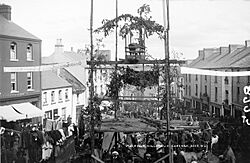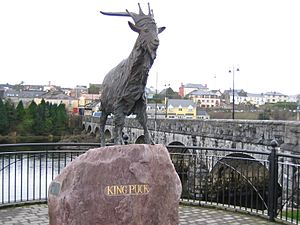Puck Fair facts for kids
The Puck Fair is one of Ireland's oldest and most exciting festivals. It happens every year from August 10th to 12th in a town called Killorglin in County Kerry, Ireland. Its Irish name, Aonach an Phoic, means 'Fair of the He-Goat'.
Contents
What Happens at Puck Fair?
Every year, a special group of people goes up into the MacGillycuddy's Reeks mountains. Their mission is to find and catch a wild goat. This goat is then brought back to Killorglin.
A young schoolgirl from the area is chosen to be the "Queen of Puck." She has the important job of crowning the goat "King Puck." This is a big moment for the festival!
After being crowned, King Puck is placed in a small cage on a tall stand. He stays there for a few hours each day of the fair. On the third day, he is brought down and safely returned to the mountains. The crowning of King Puck officially starts the fun and celebrations in the town.
Markets and Fun
The first day of the fair traditionally features a horse market. On the second day, there is a cattle market. Many street sellers also set up stalls during the festival. They sell all sorts of interesting things to the many visitors who come to Killorglin.
The local pubs are allowed to stay open later than usual during the fair. This helps everyone enjoy the festive atmosphere even more.
History of Puck Fair
The Puck Fair is very old, but its exact beginnings are a bit of a mystery. We know it has been an official event since 1613. That year, King James I gave it legal status.
Legends of its Origin
There are several interesting stories about how the fair began. One popular legend tells of a wild goat that saved the town. During the 17th century, Oliver Cromwell's army was attacking parts of Ireland. One day, a goat broke away from its herd in the mountains. It ran into Killorglin, warning the people that soldiers were nearby. The townspeople were alerted and quickly protected their homes and animals. The fair is said to honor this brave goat.
Another idea is that the fair comes from ancient times, even before Christianity. Some scholars think it might be linked to Lughnasa. This was a Celtic festival that celebrated the start of the harvest season. The goat might have been a symbol of good luck and new life.
Past Events and Cancellations
In 1905, a King Puck goat named King Skellig Mör became famous. He was even bought by a group called the Knights of Saint Brendan. After some discussion, he was given to a ship, the USS Vermont, to be its mascot!
In 1941, a ballet called Puck Fair was performed in Dublin. It was based on a poem about the fair.
The festivals in 2020 and 2021 had to be cancelled because of the COVID-19 pandemic. However, the event returned in 2022. That year, it was very hot, so King Puck was taken down from his stand for breaks to keep him comfortable.
In 1993, the folk singer Christy Moore released an album titled King Puck.
See also



